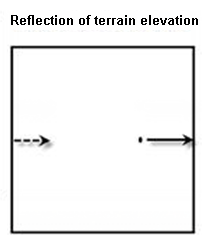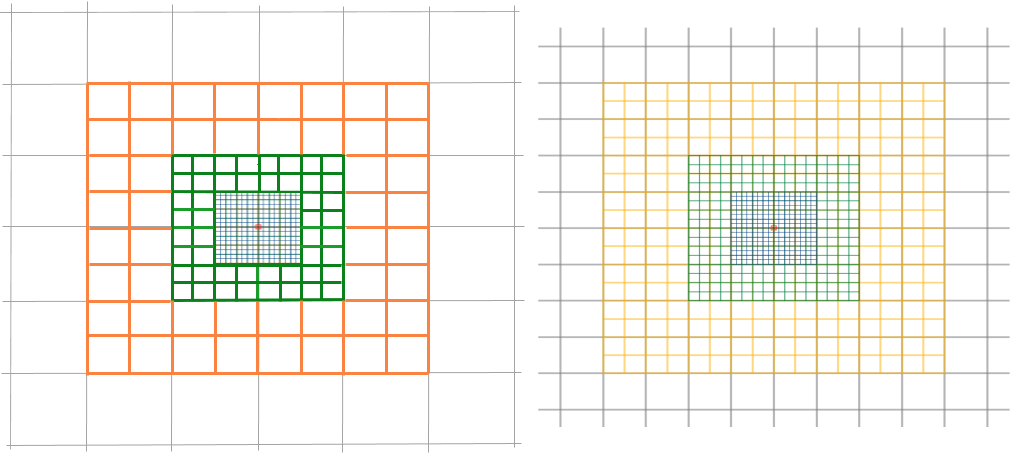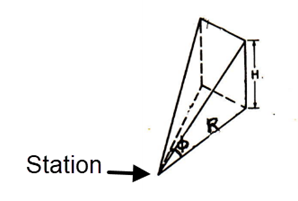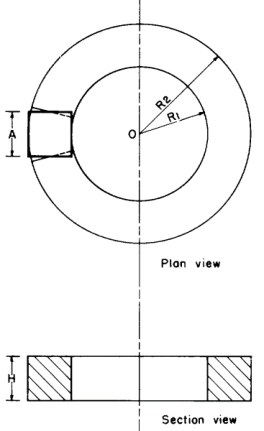Terrain Correction (Moving Platform)
Use the Moving Platform Gravity > Terrain Corrections > Terrain Correction menu option (geogxnet.dll(Geosoft.GX.Gravity.TerrainCorrection;RunForMovingPlatform)*) to calculate gravity terrain corrections. The survey terrain corrections are calculated from the database, using a correction area of 2 × correction distance by 2 × correction distance, centered on each station. The results will be stored in the output terrain correction channel.
Terrain Correction dialog options
|
Survey type |
Specify whether the gravity survey is one of the following:
Script Parameter: GRTERAIN.SURVEYTYPE |
|
Elevation channel |
Select the elevation channel, which represents the survey platform's elevation—ship elevation for shipborne surveys or flight elevation for airborne surveys. For shipborne surveys, specifying an elevation channel is optional.
Script Parameter: GRTERAIN.ELEVCH |
|
Topography (top of rock) grid |
Specify the most detailed grid that defines the boundary between solid rock and either air or water. If the survey area includes multiple bodies of water, this grid defines the contact between solid material and air over water and the contact between the solid material and air everywhere else. The topography grid must fully cover the survey area and ideally extend to the correction distance. It should also include the regional DEM data, unless the regional correction grid is used (available in script mode only). Regional data should generally extend up to 300 km beyond the survey area. If the grid does not cover the full correction distance, terrain is assumed to reflect across the grid’s opposite edges to reach the required distance. For instance, a correction distance applied along an azimuth of 90° (positive X direction) would continue its path beyond the grid boundary and re-enter from the west edge, maintaining the 90° azimuth (see Figure 2). Script Parameter: GRTERAIN.DEMGRD |
|
Correction distance |
Specify the correction distance. This is the distance beyond the survey area to be included in terrain effect calculations, and it depends on the degree of topographic relief (refer to the Application Notes for guidance). Script Parameter: GRTERAIN.DIST |
|
Earth density |
Specify the density of the earth in grams per cubic centimetre (g/cm³). The default value is 2.67 g/cm³. Script Parameter: GRTERAIN.DENST |
|
When bodies of water are present within the survey area, you can define the water level using either a constant value or a grid.
Refer to the Application Notes for a visual illustration. Script Parameter: GRTERAIN.WATEROPT |
|
|
Water reference elevation or DEM (contact with air) grid
|
This is a contextual entry:
|
|
Bathymetry channel |
If surveying over water, select the bathymetry channel (required for shipborne surveys). This channel represents the water column depth (positive downward). Previously, a "Water" (depth) channel was required. Now, you can explicitly select a bathymetry channel. If a channel named "Bathymetry" exists in the database, it will be selected by default. For compatibility, if no bathymetry channel is defined but a "Water" channel is available, the system will automatically default to it. Script Parameter: GRTERAIN.BATHYMETRY |
|
Water density |
Specify the water density in grams per cubic centimetre (g/cm³). The default value is 1.00 g/cm³. Script Parameter: GRTERAIN.WATERDENS |
|
Output terrain correction channel |
Select the channel where the terrain correction effect will be stored. Script Parameter: GRTERAIN.TCORCH |
|
Optimize Process |
Enable this option to speed up calculations. Terrain correction over large DEM grids can be computationally intensive. When selected, this optimization improves performance by desampling the outer zones to a coarser averaged grid and applying 4×4-point spline interpolation to determine the elevation from the grid. In a test grid of 2500×2500 cells, optimisation yields a 10× performance improvement with only a 3% reduction in accuracy compared to unoptimised calculations.
Refer to the Application Notes for a visual illustration. Script Parameter: GRTERAIN.OPT |
Application Notes
Gravity terrain correction is a computationally intensive process. When the Oasis montaj gravity workflow was first developed, it introduced the concept of detailed local terrain contribution versus an averaged regional contribution. The latter was computed once to speed up calculations. This approach represented a compromise between faster computational speed and the precision required to account for far-field contributions. In the original workflow, users had to ensure that the local and regional grid nodes aligned properly. However, with advances in computational power, the old dual-step model became redundant. A regional correction grid calculation was no longer needed, as it no longer offered a computational advantage. As of version 2025.1, the terrain effect at each gravity station should be calculated using a single distance equivalent to the far distance.
Definitions:
- Topography: The rise and fall (variation in elevation) of landmasses relative to sea level. Topography can extend below the surface of bodies of water.
- DEM (Digital Elevation Model): A digital representation of the Earth's surface topography. It defines the contact of material (rock or water) with air.
Terrain correction accounts for the effects of topography variability. The gravitational attraction of a landmass above the observation station pulls away from Earth, decreasing the gravitational effect of the underlying slab: Figure 1 - a) Solid rock. Similarly, a mass deficiency in the vicinity of the station causes a negative gravitational effect due to the lack of material and, consequently, diminished attraction: Figure 1 - b) Air.
Figure 1: Schematic illustration of Bouguer slab, terrain, and variable water elevations
Topography Grid
The topography grid is centered on the gravity survey area and should extend at least the correction distance beyond the edges of the survey perimeter. Dummy terrain values are interpolated using a weighted average of the surrounding points.
If the grid does not extend sufficiently beyond the survey area, and the specified correction distance exceeds the gap between the topography grid outline and the survey perimeter, the grid will be extended to meet the required margin. This extension is simply the other edge of the topography grid reflected on the opposite side. However, this is a fallback method and may introduce errors in terrain effect calculations if the nature of the topography changes significantly or if the survey terrain has a regional slope. The correction distance should therefore be selected carefully to avoid introducing errors at stations near the edge of the defined topography grid.
Figure 2: Reflection of terrain elevation on opposite sides
Digital gridded terrain models are often available from government sources and can help simplify the application of regional terrain corrections. Additionally, if there are a sufficient number of known elevation points (X, Y and Elevation), a gridded terrain model can be produced using the RANGRID or BIGRID tools.
Topography grids can be generated by combining DEM data with locally surveyed bathymetry. For surveys over coastal regions, the topography terrain grid would be a merge of the DTM and bathymetry data.
These grids should not be gridded to a cell size significantly smaller than the original sampling accuracy of the DEM data. If the topography grid is produced by gridding the elevation of the gravity survey, the grid cell size should be approximately half the nominal spacing between gravity stations.
Terrain Correction Methods
Terrain corrections are calculated using a combination of the methods described by Nagy (1966)1 and Kane (1962)2. The terrain effect is derived using an annular ring segment approximation applied to square prisms. The algorithm sums the effects of four sloping triangular sections that define the surface between the gravity station and the elevation at each diagonal corner. In the intermediate zone, terrain effects are calculated for each point using Nagy's flat-topped square prism method. In the far zone (beyond 16 cells), terrain effects are derived based on Kane's annular ring segment approximation of a square prism.
To calculate the correction at each gravity station, the topography grid is resampled and centered on the station, then extended to the specified correction distance (see Figure 2). The correction is calculated using a series of concentric square zones. The total terrain correction is the sum of the effects from each zone:
- Near zone (Zone 0): A 1-cell radius square ring centered on the station.
- Intermediate zones:
- Zone 1: Extends from 2 to 8 cells from the station; treated as flat-topped square prisms.
- Zone 2: Extends from 9 to 16 cells from the station.
- Far zones (Zone 3 and beyond): Concentric flat-topped square rings beyond 16 cells. The number of far zones depends on the defined correction distance.
Each zone is aligned with the next, ensuring consistent spatial coverage. To reduce computation time, the far zones are progressively desampled by a factor of 2, with each cell representing the average of the grid values it covers— see Figure 3, right side:
-
Zone 2: Every 4 adjacent DEM cells are averaged into one cell.
-
Zone 3: Every 16 adjacent DEM cells are averaged into one cell.
-
And so on.
When the Optimize process option is enabled, the desampling factor increases from 2 to 4, further enhancing performance— see Figure 3, left side:
-
Zone 2: Every 16 adjacent DEM cells are averaged into one cell.
-
Zone 3: Every 64 adjacent DEM cells are averaged into one cell.
-
And so on.
Each zone covers the same area but uses coarser resolution as its distance from the station increases. This hierarchical approach ensures that high-resolution detail is preserved where it matters most—near the station—while using lower-resolution data in more distant areas to reduce computational load without significantly impacting accuracy.
Figure 3: Resampling of DEM for each gravity station by zones
Additional considerations:
-
Grid edge reflection: The grid is mirrored at its edges to ensure corrections extend to the required radius.
-
Dummy value handling: Any dummy values in the grid are interpolated using adjacent non-dummy values before terrain correction is calculated.
-
Outer correction compensation: Beyond the outer (regional) correction distance, the system applies the grid’s average elevation to account for remaining terrain effects.
Equations
Zone 0: Sloped triangle (Kane)
Innermost 4 prisms:

Where:
g = the terrain effect
D = the density
G = the gravitation constant
Zones 1 & 2: Right rectangular prism (Nagy)
1 to 8 cells away from station:
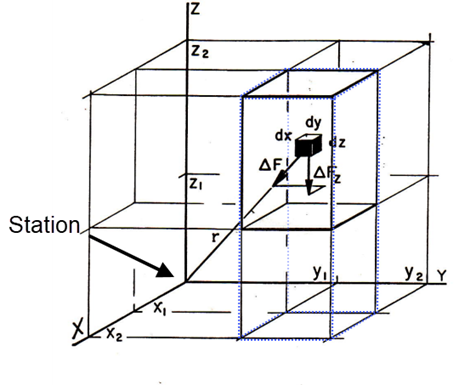

The three bars indicate the limiting values x1, x2 – y1, y2 - z1, z2. The above notation expands to 9 terms, each with a combination of xi, yj, zk.
Zone ≥3: Square segment ring (Kane)
Beyond 8 cells away from station up the specified inner distance:

Shipborne and Airborne Surveys
For shipborne and airborne surveys, corrections are calculated as follows:
-
Using the flat-topped square prism approach of [Nagy ,1966]1 for the near and intermediate zones.
-
Using the rod formula [Telford et al.,1976]3 for the far zone.
The water depth in the "Water" channel must be populated with positive values if there is water beneath the survey station. For shipborne surveys in particular, this is essential—leaving the water channel blank or with non-positive values will result in a dummy grid.
Script Mode
The following parameters are available only when executing the current GX from a script:
|
Terrain correction grid: Contains the correction values beyond the survey area, extended by the specified correction distance. The magnitude of the correction in the terrain correction grid is normalized and scaled to the provided Earth density, then added to the terrain correction calculated from the more finely sampled topography grid. Script Parameter: GRTERAIN.CORGRD |
|
Local slope channel: The local slope of the grid is calculated on the fly; however, if local slopes have been measured at each station, you can specify the slope channel. (The slope is only applicable to Zone 0; see the Application Notes section.) Script Parameter: GRTERAIN.SLOPCH |
References
- [1] D. Nagy, "The Gravitational Attraction of a Right Rectangular Prism", Geophysics, vol. 31, no. 2 (1966), pp. 362–371
- [2] M. F. Kane, "A Comprehensive system of terrain corrections using a digital computer", Geophysics, vol. 27, no. 4 (1962), pp. 455-462
- [3] W. M. Telford et al., Applied Geophysics, Cambridge: Cambridge University Press (1976), p. 59
*The GX.NET tools are embedded in the geogxnet.dll file located in the \Geosoft\Desktop Applications\bin folder. To run this GX interactively (outside the menu), first navigate to the bin directory and provide the GX.NET tool in the specified format. See the Run GX topic for more guidance.
Got a question? Visit the Seequent forums or Seequent support
Copyright (c) 2025 Bentley Systems, Incorporated. All rights reserved.
Privacy | Terms of Use


